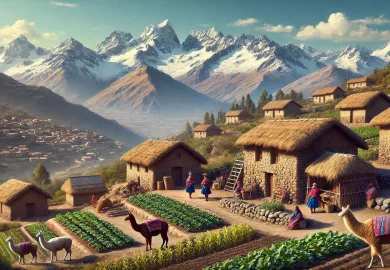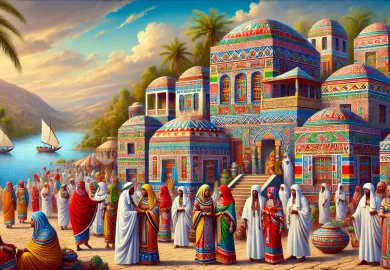
The Inuit culture, originating in the Arctic regions of Canada, Greenland, and Alaska, is a vivid tapestry of tradition, art, and survival finely woven over thousands of years. This culture, thriving under some of the harshest conditions on Earth, is not only about survival but also about a community that values cooperation, respect, and a profound connection to nature. The Inuit people, with their deep-rooted beliefs and unique practices, offer a compelling study of how human societies adapt to their environments and maintain their cultural heritage over centuries.
The Spiritual and Social Beliefs of the Inuit
Inuit spirituality and social structures are closely intertwined, reflecting their deep connection with the environment and the animals they depend on. Traditionally, the Inuit believed in animism, a spiritual doctrine that attributes a living soul to animals, plants, and inanimate objects. This belief system emphasized respect for all living things, a principle that guided their hunting practices and community interactions. Shamans, known as ‘angakkuq’, played a vital role in the Inuit communities, acting as healers and mediators between the spirit world and the people. These spiritual leaders would perform rituals to appease the spirits, ensuring safety and success in hunts.
Community life among the Inuit is characterized by cooperation and sharing, principles essential for survival in the Arctic. The concept of “Inuit Qaujimajatuqangit,” which translates to “traditional Inuit knowledge,” underscores the importance of community wisdom in governance and daily life. This knowledge is passed down through generations, ensuring that the culture and traditions endure. The Inuit also practice a unique form of justice focused on restoration rather than punishment, reflecting their values of reconciliation and community harmony.
Social gatherings, particularly during long winter months, are crucial for maintaining social bonds and passing on traditions through storytelling, dance, and games. These gatherings are not only recreational but serve as vital educational platforms where the young learn from elders, ensuring the continuity of cultural practices and values.
Traditional Inuit Lifestyle and Hunting Practices
The traditional Inuit lifestyle is intricately linked to the Arctic environment, with hunting and fishing being central components of daily life. The Inuit are expert hunters, specializing in catching seals, whales, caribou, and fish, which provide essential nutrients and materials for clothing, tools, and shelter. Their hunting techniques, honed over millennia, showcase an intimate knowledge of the Arctic wildlife and its seasonal cycles. Dogsleds, kayaks, and umiaks (large boats) are traditionally used to navigate the challenging Arctic terrain and waters.
Clothing among the Inuit is a testament to their ingenuity and adaptation to the Arctic climate. Garments are typically made from animal skins and fur, designed to offer maximum insulation and flexibility. The parka, now a common winter garment worldwide, originated from the Inuit. Their clothing designs are practical yet intricate, often decorated with symbolic motifs that reflect familial ties and cultural identity.
Housing in traditional Inuit communities features the iconic igloo, constructed from precisely cut snow blocks. These structures are particularly used during hunting expeditions in the winter. In more permanent settlements, the Inuit constructed sod houses partially dug into the ground, using materials that provided good insulation and were readily available in the Arctic environment.
Inuit Art and Craftsmanship
Inuit art is a window into the soul of the Arctic. It encompasses a range of mediums, including carving, printmaking, and sewing, each telling stories of the natural world, myths, and everyday life. Stone, bone, and ivory carvings are particularly prominent, with artists often depicting animals and human figures with a blend of realism and spirituality. These carvings not only serve as cherished possessions but are also important items of trade and economic support for many communities.
Printmaking, introduced in the 1950s, has become a significant aspect of Inuit culture, with communities like Cape Dorset, known as the capital of Inuit art, leading the way. These prints often feature bold designs and vibrant colors, capturing the dynamic essence of Inuit myths and life. Sewing and textiles are also critical components of Inuit craftsmanship, with intricate beadwork and embroidery adorning clothing and accessories.
Modern Challenges and Cultural Preservation
Today, the Inuit face numerous challenges as modernization and climate change impact their traditional way of life. However, there is a strong, ongoing effort among the Inuit to preserve and revitalize their language and customs. Initiatives to document and teach the Inuktitut language to younger generations are vital in this cultural preservation. Additionally, political movements aim to secure greater autonomy and recognition, ensuring that Inuit voices are heard on a national and international stage.
Inuit organizations, such as the Inuit Tapiriit Kanatami in Canada, play a crucial role in advocating for the rights and welfare of the Inuit, promoting sustainable development, and ensuring that the cultural heritage is preserved and passed on to future generations. International collaborations also help raise awareness about the impacts of climate change on the Arctic regions, advocating for policies that protect these fragile environments and the communities that depend on them.
In conclusion, the culture of the Inuit people is a profound reminder of the resilience of human societies and the strength of community ties in preserving cultural identity. As they navigate the challenges of the 21st century, the Inuit continue to teach the world about sustainability, respect for nature, and the importance of cultural diversity.








